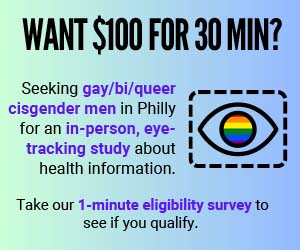Here at ActionAIDS, we couldn’t agree more with the recent federal court ruling that Pennsylvania’s law prohibiting same-sex marriage should go “into the trash heap of history.” We’re also delighted that Gov. Tom Corbett promptly decided not to appeal the case, thus establishing Pennsylvania as the 19th state (plus the
District of Columbia) where same-sex marriage is legally recognized, with many other states having followed since. Right now, more than 60 percent of the U.S. population lives in states that recognize the right, and we expect even more states to follow quickly.
But how does same-sex marriage relate to our mission of creating the first AIDS-free generation? In several different ways, as researchers on this topic have demonstrated.
Over the past several decades, we’ve witnessed a continuous sea change in societal attitudes, both about homosexuality and HIV/AIDS. Judge Jones’ ruling is just yet another indication of the changing attitudes about sexual orientation. Public opinion has been steadily more accepting of same-sex marriage, and by February, a Quinnipiac University poll of Pennsylvanians found that 57 percent supported same-sex marriage, 37 percent were opposed and 6 percent were undecided. But we still have a long way to go, and the legal recognition of same-sex marriage is an important one in addressing the problem of “minority stress,” which has negative physical and mental-health impacts within the LGBT community.
Indeed, researchers have documented that the LGBT community has significantly compromised health-care delivery and adverse health outcomes when compared with the population at large. In Jones’s ruling striking down the prohibition on same-sex marriage, he found that the “plaintiffs suffer a multitude of daily harms, for instance, in the areas of childrearing, health care, taxation and end-of-life planning.” Jones characterized these as “stigmatizing harms” that are “profoundly personal to plaintiffs and all other gay and lesbian couples, married or not.” Jones might also have mentioned, although it was not directly relevant to the issues in the case, that this stigma also affects gay men and lesbians who are not in couples.
Along precisely these lines, in comparing married heterosexual couples, married same-sex couples and LGBT individuals who are not in a legally recognized relationship, researchers have found disparities in levels of psychological distress. Married heterosexuals experience the lowest level of distress, while married same-sex couples are significantly less distressed than LGBT persons who are not in legally recognized relationships. Legal recognition of same-sex marriage thus removes a significant source of stigma, and may confer health benefits that reduce the disparity in health outcomes between the LGBT community and the population at large.
Another important health-improving result of recognition of same-sex marriage is the increase in the number of people with health insurance, particularly insurance provided by employers, which in turn enhances access to health-care services. Men and women in same-sex relationships are generally less likely to have employer-sponsored health insurance than are their married counterparts in opposite-sex relationships. This disparity, however, is narrower in areas where same-sex marriage is recognized and is greater in areas where it is not.
This positive impact of marriage on health is reported in other studies as well. One such study, for example, shows that during the year after the legalization of same-sex marriage, sexual-minority men had a statistically significant decrease in medical care visits, mental-health care visits, and mental-health care costs, compared with the year before same-sex marriage was legalized. This study also found, quite remarkably, that the positive health effect of same-sex marriage laws was similar for partnered and non-partnered men. A similar finding is that people with HIV have a longer life expectancy when in stable relationships, compared to those not in such relationships. In yet another study, researchers asked the study participants to report on their health status. Married men in same-sex couples were more likely to report having “excellent health” than men in unmarried mixed-sex couples. They were no more likely to report “excellent health” than men in married mixed-sex couples, thus showing no disparity between same- and mixed-sex married couples.
So does this stigma — or its attenuation by recognizing same-sex marriage — have an impact on HIV/AIDS? First, at least one investigation of HIV and antigay intolerance supports the view that intolerance is a factor that affects HIV-infection rates. The researchers in this study examined data from the mid-1970s to the mid-1990s and found that tolerance of gay men is “negatively associated with the HIV rate.” The researchers found this evidence to be consistent with the theory that tolerance allows low-risk men to partner with other low-risk men, while sexually active men “substitute away from underground, anonymous and risky behaviors.” In a similar study specifically looking at legal recognition of relationships, researchers found that legal recognition actually does affect behaviors involving risk of HIV transmission: Men in legally recognized relationships are less likely to engage in sexual encounters outside the relationship. But it’s the fact of legal recognition that makes a difference, not just the fact that it is a long-term, stable — but legally unrecognized — relationship. A study involved men in California, New York and Illinois during the 1990s, before any of those states had recognized same-sex marriage; all of them do today. The study found that men in domestic partnerships — a legal status not equivalent to marriage, but nevertheless a legally recognized status — had a statistically significantly lower number of sexual partners and lower rates of condomless anal intercourse with partners other than their domestic partner. As a result, men in these domestic partnerships had decreased risk behaviors for STDs, including HIV infection. Other studies have shown some effects of legal recognition of same-sex marriage and STI and HIV rates, but are less conclusive. A 2008 study concluded that empirical evidence is consistent with the view that gay marriage reduces risky sexual behavior. Analyzing data from European countries, that study found that legal recognition of same-sex partnerships led to “large and statistically significant reductions in syphilis rates” — by approximately 24 percent. But at the same time, attempts to estimate the effect of gay marriage on gonorrhea and HIV yielded results that were “smaller and statistically insignificant,” although syphilis plays a significant role in the spread of HIV.
In 1986, when ActionAIDS was founded, it was far too common that a diagnosis with AIDS was the event that “outed” a gay man whose sexual orientation may have been something that he didn’t share with his family, certain friends or neighbors or his employer. Too often, the response to a diagnosis was both AIDS-phobic and homophobic — employees were fired from their jobs, ostracized by friends and neighbors and abandoned by their families. This disapproval was based not only on the AIDS diagnosis, which many people found frightening, but also because of intolerance of homosexuality. For many people, homosexuality and AIDS thus became equivalent and interchangeable in terms of disapproval. ActionAIDS was founded because of the need for compassionate, not disapproving, recognition of people with AIDS as human beings in need, without judgmental attitudes about sexual orientation. We’re pleased that the recent court ruling legalizing same-sex marriage in Pennsylvania is another step in putting those disapproving attitudes into the ash heap of history.

